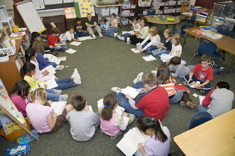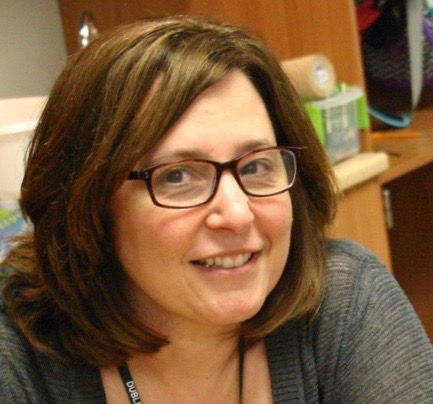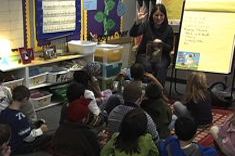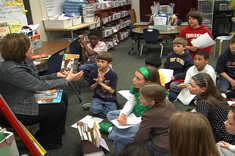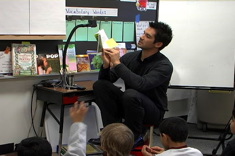As an elementary teacher, it is so easy to find great fiction texts to read aloud to students. There are many books to choose from, and I can readily envision my students enjoying fiction read alouds and then going back to read these books on their own during reading workshops. It is no wonder that many of our students feel more comfortable reading fiction than nonfiction, since so many read alouds focus on fiction.
I have noticed that when I choose nonfiction to read aloud, I am often looking for content connections. Unlike fiction read alouds, I very seldom read aloud nonfiction books that are just interesting or fun reads. I try to read aloud nonfiction that is connected to my science, math, or social studies curriculum. The more I work with students, the more I see this gap in my teaching. By always choosing nonfiction with curriculum connections, I am focusing more on curriculum content rather than reading for pleasure. I am not necessarily giving students the skills and experiences they need to understand the full range of genres, topics and possibilities for reading nonfiction. Here are some of my favorite nonfiction read-alouds for expanding my sense, and my students' sense, of the power and purpose of nonfiction.
Books About Animals
Animals always fascinate children. We tend to read books to students that connect to our curriculum but there are so many others that are fascinating. Kids were immediately fascinated with the story of Owen & Mzee: The True Story Of A Remarkable Friendship, the story of a turtle and a hippo who became unlikely friends, written by Isabella Kathkoff. This book is a great one to read aloud because it is told in narrative form and is a story. Kids are familiar with story features, so this is a good text for transitioning to nonfiction.
A new favorite about animals introduced to me by a librarian colleague is Elephants Can Paint Too! by Katya Arnold. In this book, the author shares the way she works with elephants to teach them to paint. There are two layers of text – some simple text, and some more complex narrative about the elephants. This book can be read by just reading the simple text, or by delving more deeply in the more sophisticated descriptions about the elephants. A more complex book on a similar theme is Animals Nobody Loves
by Seymour Simon. In this book, Simon shares information about animals that are not well liked by humans. Each page stands alone, so the entire book does not need to be read aloud. This book provides a great opportunity for modeling ways to choose a part of a book or page to read in a nonfiction text, rather than reading the book cover to cover.
Hero Dogs: Courageous Canines in Action by Donna M. Jackson is another engaging nonfiction read with several separate stories about dogs. I like to use books by Steve Jenkins for read alouds. The way in which he organizes information, combined with his unique art, makes for great reads. His book Actual Size
, comparing animals to other things, lends itself to reading aloud with close attention to the illustrations.
Biographies
Biographies are an important type of nonfiction. Unfortunately, often our kids think of reports when they think of biographies. I have worked to collect several picture book biographies – books that can be read in one to two sittings. In a short time, students can learn so much about a person who has made a difference in the world by reading these books. A favorite among many students is You Forgot Your Skirt, Amelia Bloomer by Shana Cory. Students love to learn about the woman who invented bloomers and the fight for women's rights. Martin's Big Words: The Life of Dr. Martin Luther King, Jr.
by Doreen Rappaport is a wonderful read aloud for all ages. First person memoirs such as Knucklehead: Tall Tales and Almost True Stories of Growing up Scieszka
by Jon Scieszka and Marshfield Dreams: When I Was a Kid
by Ralph Fletcher also make terrific read alouds because students love to hear about their favorite authors' childhoods.
My students have enjoyed Chimpanzees I Love: Saving Their World And Ours by Jane Goodall. This is the fascinating story of Jane Goodall and her work. This book is a longer book and cannot be read in one sitting. It feels more like a "chapter book" and is a good transition to longer nonfiction books that can be read cover to cover. We Are the Ship: The Story of Negro League Baseball
by Kadir Nelson is another longer book for students ready for a more sophisticated read aloud.
There are some new graphic biographies being written for children. A favorite among older elementary students is Satchel Paige: Striking Out Jim Crow by James Sturm. If you have access to a document reader so that students can see the pages as you read, the visuals give students another way to think about ways to present facts and information beyond words.
Noticing Craft in Nonfiction
There are some nonfiction books that are written in ways that you can't help but notice their amazing language. I try to add books like these to my stack of nonfiction read alouds so that students can see variety in the ways that nonfiction can be written. Two favorite picture books that use great language are An Egg Is Quiet and A Seed Is Sleepy
, both by Diana Hutts Aston. Another great author is Nicola Davies. Her books like Bat Loves the Night: Read and Wonder
make good read alouds that invite students to savor the language of quality nonfiction.
How-To Reading
How-to nonfiction is often difficult to read aloud, yet I want my students to be exposed to this type of writing. I have found several fiction picture books that are written in a how-to format – books that have many characteristics of nonfiction, but are not categorized in that way. Amelia Makes a Movie by David Milgrim, How To be A Baby . . . By Me, The Big Sister
by Sally Lloyd-Jones and The Younger Brother's Survival Guide
by Lisa Kopelke are three great fiction picture books that expose students to this type of nonfiction text.
Books with Interesting Formats
Nonfiction books come in so many interesting formats that I like to share a variety of these unusual styles with students. Many of the books that I read aloud can be read cover to cover, but books like the Why Why Why Does the Earth Spin Around? Series can be read in any order. I want my students to know this. Included in this category of read alouds are nonfiction alphabet books. Question and Answer books such as Why Why Why Can't Penguins Fly?
by De La Bedoyere. Students also enjoy Frank Serafini's Looking Closely along the Shore
. Not only are the photos stunning, but the books are packed with information. Finally, two books that have the fun of an I Spy Treasure Hunt
book but that teach kids skills needed for estimation are Great Estimations
and Greater Estimations
by Bruce Goldstone.
Nonfiction Poetry
I have been discovering more nonfiction in poetry forms – poems that teach readers about something interesting. These are not often the books kids would pick up on their own. But if we spend time reading a few poems aloud, children find them fascinating and may add them to their reading lives. All by Herself by Ann Whitford Paul celebrates famous women in history. A World of Wonders: Geographic Travels in Verse and Rhyme
by J. Patrick Lewis offers interesting facts about geography. In My America: A Poetry Atlas of the United States
, Lee Bennett Hopkins explores regions of the United States through poems. Where in the Wild?: Camouflaged Creatures Concealed … and Revealed
by David Schwartz combines poetry, photos and interesting nonfiction text about animal camouflage.
Books that Young Children Could Later Read on Their Own
Since many nonfiction books are too difficult for young children to read on their own, I keep my eye out for nonfiction with simpler texts — books I can read aloud that students may later go back to on their own. Frances Barry writes fun pop-up books with simple texts. Big Yellow Sunflower and Little Green Frogs
are two amusing read alouds with simpler text. Another book that can be read by new readers is 10 Things I Can Do to Help My World: Fun and Easy Eco-Tips
by Melanie Walsh.
Kids deserve to be exposed to a variety of nonfiction books – texts in different formats, about different topics, and written by different authors. Read aloud is a perfect time for students to fall in love with nonfiction. The challenge is to read a variety of books that will hold their interest. I hope you find something within these categories that can meet the needs of the readers you are working with as you experiment with nonfiction read alouds.

